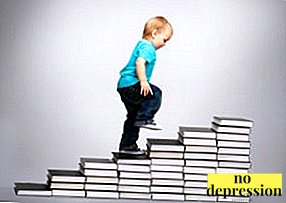Mark Twain said: “Avoid those who want to undermine your faith in yourself”.
What does self-confidence mean for us?
Psychology of self-esteem and its role in human life in the material below.
Definition, function and influence on personality

Self-esteem - this is a person's own assessment of the importance of his personality, physical, as well as moral qualities, weaknesses and merits, their conscious or unconscious manifestation.
What types or types of self-esteem in psychology classify? Characterize self-esteem can be as follows classification parameters:
- according to the level - low, high and medium;
- in relation to objective success - adequate and inadequate, overpriced.
Self-esteem is a complex mental form that reflects the degree of one’s own aspiration, acceptance or rejection of oneself as a person, and performs the following dominant functions:
- Regulatory - ensuring that the individual makes certain tasks and choices.
- Protective - the stability of the individual and its independence.
- Emotional - degree of satisfaction of the person with their characteristics.
- Developing - stimulation of the personality for self-improvement and personal development.
- Adaptive - adaptability of the person to the social environment.
- Corrective - self-control in various activities, performing any tasks.
- Prognostic - regulation of the activity of the initial period of activity.
- Motivating - motivation to take action to achieve positive self-esteem, self-satisfaction.
- Terminal - cessation of any kind of activity due to critical self-esteem, negative assessment of one’s own actions.

How does the level of self-esteem affect a person's personality?
Self-esteem in the structure of personality has a huge impact not only on the emotional state of a person in any period of time - the personality activity in various situations depends on its level, interaction with society, the work of adaptation mechanisms, which will ultimately affect his actions.
For example, with low self-esteem, a person will longer adapt in a new working team, will avoid the responsibility to take upon himself the difficult tasks, in his opinion, while the person with adequate self-assessment will quickly find a common language with new colleagues and him it will be easier to realize your abilities and professional skills.
But with an overestimation of self-esteem, there is a high probability that a person will overestimate their own capabilities and will not be able to fulfill their obligations.
About psychology and self-confidence criteria in this video:
Self-confidence and self-confidence - the difference of concepts
Such concepts as self-confidence and self-confidence should not be considered identical, because the last is the groundless conviction in the absence of negative sides, negative properties of their personal qualities, in other words - this propensity to overestimate their own capabilities.
At the same time, self-confidence is characterized by an objective attitude toward one’s personality, an adequate, real assessment of one’s abilities.
Self-confidence and self-confidence - what is the difference? Find out from the video:
Stages of formation

At what age period does self-esteem begin to form?
Is it true that a child forms self-esteem, comparing yourself to others?
The formation of human self-esteem dates back to the preschool age period. At this time, the parents and the adults around him have the greatest influence on the child. Later added educational institutions and peer environment.
Direct impact The following factors affect the child’s self-assessment:
- Assessment of the child’s actions by parents, rewards or punishments in certain situations.
- The level of intellectual development, innate abilities of the child and his personality traits.
- Social environment.
- The educational work of specialists of preschool institutions (hereinafter - schools, secondary and higher educational institutions).
Especially actively developed and formed self-esteem in the younger school age when teaching in primary school - as a result of the activities of teachers, assessment of the child's abilities, acceptance or rejection of his teacher.
Subsequently, the child seeks to win recognition and authority in the peer collective, is influenced by their judgments about him. At the same time, the child compares social reactions to himself and his actions, assessing his qualities with his own, compares itself with other individuals.
Factors affecting it

What factors affect the self-esteem of the individual? What self-esteem depends on:
- Family factors. If parents consciously or unconsciously seek to put the child in a subordinate, dependent on them position, this can lead to unduly low self-esteem. At the same time, the promotion of the child’s free choice and his independence has a positive effect on the child’s assessment of his or her own capabilities.
- Social factors. In addition to their own qualities and abilities compared with the achievements of other individuals, an important role is played by the position of the child's parents, their social status. This is especially evident in adolescence.
What factors influence self-esteem? The psychologist comments:
Level of claims
There is a so-called "Image of me", which is a set of processes of the psyche, through which the individual is aware of himself as a subject that produces any activity.
This is not only the concept of oneself, the awareness of oneself, but also the perception, the attitude of the individual to itself. "The image of I" can be represented in the form of three components:
- informative - that is, self-awareness;
- emotionally assessed - attitude and assessment;
- behavioral - regulation of their own behavior.
These components simultaneously live in a person, and the “image of the I” itself is not static and is constantly changing and striving for perfection.
At the same time, a person feels certain desires, expectations from myself, and with the help of self-assessment, it regulates its behavior, choosing the middle ground between difficult and easy tasks on the way to achieving the desired perfection.
Diagnostics
The level of self-esteem can be diagnosed by various methods.
Methods for primary school students
 Method "ladder". With this method, the child shows a ladder drawn on a sheet of paper consisting of 10 steps and states that children with mediocre abilities are on the lower steps, and the most good, capable and intelligent ones are on the upper steps. Next, the child must choose the step, which would correspond to himself. The result is estimated as follows: 1-3 steps - low self-esteem, 4-7 steps - normal, average, 8-10 steps - overestimated.
Method "ladder". With this method, the child shows a ladder drawn on a sheet of paper consisting of 10 steps and states that children with mediocre abilities are on the lower steps, and the most good, capable and intelligent ones are on the upper steps. Next, the child must choose the step, which would correspond to himself. The result is estimated as follows: 1-3 steps - low self-esteem, 4-7 steps - normal, average, 8-10 steps - overestimated.- The method of "three estimates." Pupils are given any written assignments, not necessarily complex, after which their results of their work are evaluated by three grades - excellent, normal, low. It is explained that their work was evaluated by three different teachers and then the pupils should circle the grade with which they agree.
At the same time, the adequacy of the student's own assessment is also evaluated, as well as the argumentation of the quality of the work performed.
How to determine the attitude of the child to his own "I"? Watch the video:
Verbal
According to this method, the person being diagnosed is asked to answer a number of questions relating to his self-assessment, or suggestions are offered that he may agree with, disagree with, or not fully agree with.
For each answer, a specific ball is awarded. In accordance with the developed scale is determined by the level of self-esteem..
Beck Depression Scale

In 1961, the American psychologist A.T. Bek created a test in which the patient chooses the most acceptable statements.
The questionnaire was compiled on the basis of the most common complaints of people suffering from depression and represents 21 symptoms of depression.
Each item is scored, the sum of which says about one of 5 levels of depression.
About the Beck scale for self-assessment and assessment of the severity of depression:
Spielberger-Hanin Anxiety Graph
The test consists of 40 questions allowing to determine the level of anxiety of a person - the tendency of an individual to perceive a wide range of situations as threatening, dangerous - the so-called personal anxiety, and reactive anxiety, characterized by nervousness and anxiety. The scale is divided into two corresponding parts.
Spielberger-Khanin test.
Budassi technique
Using the method of self-assessment of personality according to Budassi, you can determine the level of self-esteem and its adequacy.
It is based on a comparison of the personality of itself with a certain standard, the results of which are used to overestimate or lower one’s own self-esteem.
Moreover, in the view of the person himself, these assessments look reliable, regardless of their objectivity or subjectivity. Tested offered for ranking 48 different personality traits - swagger, dreaminess, thoughtfulness, etc.
The method of evaluation can be done in two ways - by comparing one's own ideas with real ones, and also by comparing the person with other people.
Test budassi.
Method for assessing emotional states
This method was developed by US psychologists D. Ricks and A. Wessman. With its help it is convenient to determine emotional state of the person for any time period and identify its changes.
Formula

Psychologist W. James derived the following self-esteem formula - she equal to our real achievements divided by our claims.
In this case, there is a direct dependence of our self-esteem on the achievements and the reverse - on our expectations.
If our success is higher than our expectations, this indicates high self-esteem. If we have achieved less than what we are striving for, this indicates low self-esteem.
Self-confidence - appearances
Human behavior - whether man or woman - heavily dependent on self confidence.
Moreover, some gestures and movements that speak of true self-esteem can be made absolutely unconsciously, nevertheless, indicating to the attentive observer about the true faith of a person in himself.
What does a confident person look like? Signs:
- smile - ate a man smiles, it speaks of his openness to the world, good emotional state, happiness and a sense of comfort;
- posture - straightened shoulders, lack of stoop, free, not clamped posture, confident gait;
- sight - a confident person easily maintains the interlocutor's gaze, does not hide his eyes to the floor, does not look around with fright on the sides;
- calm, flowing movements. Man does not fidget, does not make senseless, fussy movements;
- speech - quite loud, without “swallowing” the endings of phrases.
Uncertainty, shyness, confident human behavior:
Overconfidence

Big self-confidence speaks of inadequate appreciation own capabilities.
Increased self-esteem is characterized by the following characteristics: a person is often behaves defiantly, arrogantly, believes that he is superior in quality to those around him.
Such self-esteem often leads to destructive behavior - a person misinterprets his negative experience, as a rule, writing off his failures either to circumstances or to other people, which creates obstacles to self-improvement.
Usually people are reluctant to contact with such individuals.
Low self-esteem
The next unwanted extreme - very low self-esteem.
At the same time, a person has problems with self-actualization, as he often goes away from active actions due to the fear of making a mistake.
What are the signs of an insecure man (women)? Outwardly, this is manifested in excessive shyness, slouching postures, avoiding direct eye contact, silence, and fussy movements.
Often a person does not express his opinion even to the detriment of their own interests.
Average

The average self-esteem man himself in most characterizes the most adequate look at your own opportunities.
Since self-esteem does not constitute a static value, such people are least of all subject to extremes — to overestimate their own strength and not justify their claims or expectations of those around them, or to be depressed.
In general, self-esteem significantly affects the success, emotional state and satisfaction of a person with his life. In this case, it is desirable that the subjective perception of their personal qualities coincided with an objective assessment of their surrounding people.
Why is a person not confident? What is low self-esteem and what is the cause:

 Method "ladder". With this method, the child shows a ladder drawn on a sheet of paper consisting of 10 steps and states that children with mediocre abilities are on the lower steps, and the most good, capable and intelligent ones are on the upper steps. Next, the child must choose the step, which would correspond to himself. The result is estimated as follows: 1-3 steps - low self-esteem, 4-7 steps - normal, average, 8-10 steps - overestimated.
Method "ladder". With this method, the child shows a ladder drawn on a sheet of paper consisting of 10 steps and states that children with mediocre abilities are on the lower steps, and the most good, capable and intelligent ones are on the upper steps. Next, the child must choose the step, which would correspond to himself. The result is estimated as follows: 1-3 steps - low self-esteem, 4-7 steps - normal, average, 8-10 steps - overestimated.

